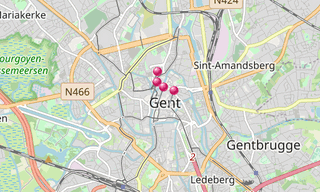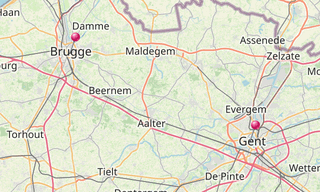Ghent is the capital of the East Flanders province. The city started as a settlement at the confluence of the rivers Scheldt and Lys and in the Middle Ages became one of the largest and richest cities of Northern Europe. Much of the city’s medieval architecture remains intact and is well preserved and restored.
Interesting highlights are the Saint Bavo Cathedral, the Belfry, the Gravensteen Castle, and the splendid architecture along the Old Graslei Harbour. The city of Gent houses also three Béguinages and numerous churches, among which the Saint James Church, the Saint Nicolas Church and the Saint Michael Church are the most beautiful examples.
The Béguinages, as well as the Belfry and adjacent Cloth Hall (Lakenhalle), were recognised by UNESCO as World Heritage Sites in 1998 and 1999.
Main sights
- The Saint Bavo Cathedral (Sint-Baafskathedraal) is an 89-meter-tall Catholic, Gothic cathedral in Ghent. It is the seat of the diocese of Ghent, is named for Saint Bavo of Ghent, and contains the well-known Ghent Altarpiece. The building is built on the site of the former Chapel of St. John the Baptist, primarily of wooden construction that was consecrated in 942 by Transmarus, Bishop of Tournai and Noyon. Construction of the Gothic church began around 1274.
- The 91-metre-tall Belfry of Ghent is one of three medieval towers that overlook the old city centre of Ghent, the other two belonging to Saint Bavo Cathedral and Saint Nicholas’ Church. Its height makes it the tallest belfry in Belgium. Construction of the tower began in 1313 after a design by master mason Jan van Haelst.
- The Gravensteen (Castle of the Counts) is a medieval castle at Ghent. The current castle dates from 1180 and was the residence of the Counts of Flanders until 1353. It was subsequently re-purposed as a court, prison, mint, and even as a cotton factory. It was restored over 1893–1903.
- The Graslei (Grass quay) is a quay in the historic city center of Ghent, located on the right bank of the Leie river. The quay opposite of the Graslei is called Korenlei. Both quays were part of the medieval port.
- The Korenlei (Corn quay) is a quay in the historic city center of Ghent, located on the left bank of the Leie river. The quay on the opposite bank of the Leie is Graslei.
- The Saint Nicholas Church (Sint-Niklaaskerk) is one of the oldest and most prominent landmarks in Ghent. Begun in the early 13th century as a replacement for an earlier Romanesque church, construction continued through the rest of the century in the local Scheldt Gothic style (named after the nearby river). Typical of this style is the use of blue-gray stone from the Tournai area, the single large tower above the crossing, and the slender turrets at the building’s corners.
- The town hall of Ghent (Stadhuis) is a composite set of contiguous buildings, built at different times (at least eleven building campaigns have been counted), in the most diverse styles. The oldest building in the whole complex is the Old House of the Keure dating from 1482.

-Korenlei.hero.landscape.jpg?w=1600)


.jpg?w=256)
.jpg?w=256)
-Stadhuis-van-Gent.jpg?w=256)
-Belfort-van-Gent.jpg?w=256)
-Graslei-Gildehuis-der-Vrije-Schippers.jpg?w=256)
-Leie.jpg?w=256)
-Gravensteen.jpg?w=256)
-Sint-Niklaaskerk.jpg?w=256)
-Belfort-van-Gent.jpg?w=256)
-Gravensteen.jpg?w=256)
-Oud-Postgebouw.jpg?w=256)
-Belfort-van-Gent.jpg?w=256)
-Sint-Baafskathedraal.jpg?w=256)
-Oud-Postgebouw.jpg?w=256)
-Gravensteen.jpg?w=256)
-Stadhuis-van-Gent.jpg?w=256)
-Gravensteen.jpg?w=256)
-Oud-Postgebouw.jpg?w=256)
-Graslei-Gildehuis-Den-Enghel.jpg?w=256)
-Graslei-Korenmetershuis.jpg?w=256)
-Stadhuis-van-Gent.jpg?w=256)
-Graslei-Gildehuis-der-Vrije-Schippers.jpg?w=256)
-Oud-Postgebouw.jpg?w=256)
-Sint-Baafskathedraal.jpg?w=256)
-Oud-Postgebouw.jpg?w=256)
-Belfort-van-Gent.jpg?w=256)
-Stadhuis-van-Gent.jpg?w=256)
-Graslei.jpg?w=256)
.jpg?w=256)
-Korenlei.jpg?w=256)
-Stadhuis-van-Gent.jpg?w=256)
-Gravensteen.jpg?w=256)
.jpg?w=256)
-Korenlei.jpg?w=256)
-Leie.jpg?w=256)
-Stadhuis-van-Gent.jpg?w=256)
-Stadhuis-van-Gent.jpg?w=256)
-Belfort-van-Gent.jpg?w=256)
-Leie.jpg?w=256)
-Grasbrug.jpg?w=256)
.jpg?w=256)
-Gravensteen.jpg?w=256)
-Stadhuis-van-Gent.jpg?w=256)
-Graslei.jpg?w=256)
-Graslei.jpg?w=256)
.jpg?w=256)
-Korenlei.jpg?w=256)
-Korenlei.jpg?w=256)
-Stadhuis-van-Gent.jpg?w=256)
-Gravensteen.jpg?w=256)
-Sint-Baafskathedraal.jpg?w=256)
-Sint-Baafskathedraal.jpg?w=256)
.jpg?w=256)
-Korenlei.jpg?w=256)
-Graslei-Gildehuis-der-Vrije-Schippers.jpg?w=256)
.jpg?w=256)
-Oud-Postgebouw.jpg?w=256)
-Oud-Postgebouw.jpg?w=256)
.jpg?w=256)
.jpg?w=256)
-Rozenhoedkaai.hero.jpg?w=320)
